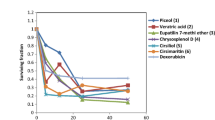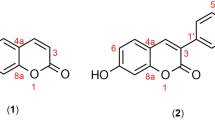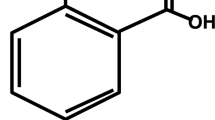Abstract
Multiple drug resistance and increased side effects due to allopathic drugs has warned scientific community with a global alarm to identify molecules from natural sources to combat diseases with minimum or no side effects. The present investigation was aimed to identify and isolate secondary metabolites from traditionally used Nerium indicum using conventional column chromatography which led to the isolation of two compounds, C-I (fractions NB4f1) and C-II (fractions NC13b1). Further characterized, it is elucidated using spectral data and identified as N-(4-hydroxy-phenyl)-2-methoxy-2-phenyl-acetamide, molecular formula C15H15NO3, and molecular weight 257.3 (C-I) and N-(4-hydroxy-phenyl)-2-phenyl-N-phenylacetyl-acetamide, molecular formula C22H19NO3, and molecular weight 345.4 (C-II). Further, the isolated compounds were investigated using in silico approach by Autodock tool with four different proteins specific for cancer and in vitro assessed cell proliferation, and apoptosis against human breast cancer MCF 7 cell line. The results of the in silico model demonstrated potent binding affinity of both compounds with the proteins representing that the isolated molecules could be a drug of choice for cancer. Further, the isolated compounds revealed significant inhibition of cell proliferation (IC50 values 21 μg/mL for C-I, 19 μg/mL for C-II) with induced apoptosis with nuclear condensation effect on the MCF 7 cells in in vitro condition even at very low concentration. Compound treatment to MCF-7 cell line represented bright fetches indicating condensed chromatins and higher level of nuclear fragmentation with DAPI staining, indicating higher cell death due to induced apoptosis and confirmed using flow cytometry analysis representing inhibition of cell proliferation at S phase.

Graphical abstract




















Similar content being viewed by others
Change history
26 February 2020
The correct presentation of the Author names are shown in this paper.
References
Abdolmohammadi MH, Fouladdel SH, Shafiee A, Amin GH, Ghaffari SM, Azizi E (2008) Anticancer effects and cell cycle analysis on human breast cancer T47D cells treated with extracts of Astrodaucus persicus (Boiss.) Drude in comparison to doxorubicin. Daru 16(2):112–118
Alabri THA, Al-Musalami AHS, Hossain MA, Weli AM, Al-Riyami Q (2014) Comparative study of phytochemical screening, antioxidant and antimicrobial capacities of fresh and dry leaves crude plant extracts of Datura metel L. J King Suad Univ Sci 26:237–243
Alonso H, Bliznyuk AA, Jill Gready E (2006) Combining docking and molecular dynamic simulations in drug design. Med Res Rev 26(5):531–568. https://doi.org/10.1002/med.20067
Baskar AA, Ignacimuthu S, Paulraj GM, Numair SA (2010) Chemopreventive potential of beta-sitosterol in experimental colon cancer model-an in vitro and in vivo study. BMC Complement Altern Med 10:2–10. https://doi.org/10.1186/1472-6882-10-24
Bayrambaş B, Çakır I, Gulseren (2019) Influence of phenolic profile on the RP-HPLC detection and anti-carcinogenic potential of cherry laurel extracts from Black Sea Region-Turkey. Microchem J. https://doi.org/10.1016/j.microc.2019.103963
Berahou AA, Auhmani A, Fdil N, Benharref A, Jana M, Gadhi CA (2007) Antibacterial activity of Quercus ilex bark’s extracts. J Ethnopharmacol 112:426–429
Bina Shaheen S, Nasima Sabira Begum K, Farooq AD, Qamar K, Bhatti HA, Ali SK (2012) Flavonoid and cardenolide glycosides and a pentacyclic triterpene from the leaves of Nerium oleander and evaluation of cytotoxicity. Phytochem:77, 238–244. https://doi.org/10.1016/j.phytochem.2012.01.001
Blundell TL, Jhoti H, Abell C (2002) High-throughput crystallography for lead discovery in drug design. Nat Rev Drug Discov 1(1):45–54. https://doi.org/10.1038/nrd706
Choi J, Chen J, Schreiber SL, Clardy J (1996) Structure of the FKBPI 2-Rapamycin complex interacting with the binding domain of human FRAP. Science 273:239–242
Congreve M, Murray CW, Blundell TL (2005) Structural biology and drug discovery. Drug Discov Today 10(13):895–907. https://doi.org/10.1016/S1359-6446(05)03484-7
Dehpour AA, Ebrahimzadeh MA, Nabavi SF, Nabavi SM (2009) Antioxidant activity of methanol extract of Ferula assafoetida and its essential oil composition. Grasas Aceites 60(4):405–412
Dey P, Roy S, Chaudhuri TK (2012) A quantitative assessment of bioactive phytochemicals of Nerium indicum: an ethnopharmacological herb Inter. J Res Pharma Sci 3:579–587
Favelyukis S, Till JH, Hubbard SR, Todd Miller W (2001) Structure and autoregulation of the insulin-like growth factor 1 receptor kinase. Nat Struct Mol Biol 8(12):1058–1063. https://doi.org/10.1038/nsb721
Globocan (2012) http://globocan.iarc.fr/Default.aspx
Gordaliza M (2007) Natural products as leads to anticancer drugs. Clin Transl Oncol 9(12):767–776. https://doi.org/10.1007/s12094-007-0138-9
Gulcin I, Mshvildadze V, Gepdiremen A, Elias R (2004) Antioxidant activity of saponins isolated from ivy: alpha-hederin, hederasaponin-C, hederacolchiside-E and hederacolchiside-F. Planta Med 70(6):561–563
Halliwell B, Gutteridge JMC, Aruoma OI (1987) The deoxyribose method: a simple “test tube” assay for determination of rate constants for reactions of hydroxyl radicals. Anal Biochem 165:215–219
Hossain MA, Al-Kalbani MAS, Al-Farsi SAJ, Weli AM, Al-Riyami Q (2014) Comparative study of total phenolics, flavonoids contents and evaluation of antioxidant and antimicrobial activities of different polarities fruits crude extracts of Datura metel L. Asian Pac J Trop Dis 4(5):378–383
Hsu HF, Huang KH, Lu KJ, Chiou SJ, Yen JH, Chang CC, Houng JY (2011) Typhonium blumei extract inhibits proliferation of human lung adenocarcinoma A549 cells via induction of cell cycle arrest and apoptosis. J Ethnopharmacol 135(2):492–500. https://doi.org/10.1016/j.jep.2011.03.048
Imaga NOA, Gbenle GO, Okochi VI, Adenekan SO, Edeoghon SO, Kehinde MO (2010) Antisickling and toxicological profiles of leaf and stem Parquetina nigrescens L. J Med Plant Res 4(8):639–643
Jain J, Jain SK (2011) Screening of in vitro cytotoxic activity of some medicinal plants used traditionally to treat cancer in Chhattisgarh state, India. Asian Pac J Trop Biomed 4:147–150. https://doi.org/10.1016/S2221-1691(11)60144-5
Jemal A, Bray F, Center MM, Ferlay J, Ward E, Forman D (2011) Global cancer statistics. CA Cancer J Clin 61(12):69–90. https://doi.org/10.3322/caac.20107
Krol M, Chaleil RA, Tournier AL, Bates PA (2007) Implicit flexibility in protein docking: cross-docking and local refinement. Proteins 69(4):750–757. https://doi.org/10.1002/prot.21698
Lans C (2007) Ethnomedicines used in Trinidad and Tobago for reproductive problems. J Ethnobiol Ethnomed 3:13. https://doi.org/10.1186/1746-4269-3-13
Loutfy S, Al-Ansary NA, Abdel-Ghani NT, Hamed AR (2005) Anti-proliferative activities of metallic nanoparticles in an in vitro breast cancer model. Asian Pac J Cancer Prev 16:6039–6046
Mukherjee A, Basu S, Sarkar N, Ghosh A (2001) Advances in cancer therapy with plant based natural products. Curr Med Chem 8(12):1467–1486. https://doi.org/10.2174/0929867013372094
Nanyingi MO, Mbaria JM, Lanyasunya AL, Wagate CG, Koros KB, Kaburia HF, Munenge W (2008) Ethnopharmacological survey of Samburu district, Kenya. J Ethnobiol Ethnomed 4:14. https://doi.org/10.1186/1746-4269-4-14
Newman RA, Kondo Y, Yokoyama T, Dixon S, Cartwright C, Chan D, Johansen M, Yang P (2007) Autophagic cell death of human pancreatic tumor cells mediated by oleandrin, a lipid-soluble cardiac glycoside. Integr Cancer Ther 6(4):354–364. https://doi.org/10.1177/1534735407309623
Oyaizu M (1986) Studies on product of browning reaction prepared from glucoseamine. Jpn J Nutr 44:307–315
Palanivel K, Gouthaman T, Vani B, Kadalmani B, Rao MV (2011) Agrobacterium rhizogene guided anti-cancer potential of Rhinacanthus nasutus in Hep2 tumor cell line. J Pharm Res 4(5):1454–1458
Pauptit RA, Dennis CA, Derbyshire DJ, Breeze AL, Weston SA, Rowsella S, Murshudov GN (2001) NMR trial models: experiences with the colicin immunity protein Im7 and the p85a C-terminal SH2±peptide complex. Acta Crystallogr 57(10):1397–1404. https://doi.org/10.1107/S0907444901012434
Poongothai K, Ponmurugan P, Syed Zameer Ahmed K, Senthil Kumar B, Sheriff SA (2011) Antihyperglycemic and antioxidant effects of Solanum xanthocarpum leaves (field grown & in vitro raised) extracts on alloxan induced diabetic rats. Asian Pac J Trop Med 10(4):778–785. https://doi.org/10.1016/S1995-7645(11)60193-4
Reboredo-Rodriguez P, Gonzalez-Barreiro C, Cancho-Grande B, Simal-Gandara J, Giampieri F, Forbes-Hernandez TY, Varela-Lopez A (2018) Effect of pistachio kernel extracts in MCF-7 breast cancer cells: inhibition of cell proliferation, induction of ros production, modulation of glycolysis and of mitochondrial respiration. J Funct Foods 45:155–164
Ribeiro N, Sousa SR, Monteiro FJ (2010) Influence of crystallite size of nanophased hydroxyapatite on fibronectin and osteonectin adsorption and on MC3T3-E1 osteoblast adhesion and morphology. J Colloid Interface Sci 351(2):398–406. https://doi.org/10.1016/j.jcis.2010.08.013
Saklani A, Kutty SK (2008) Plant-derived compounds in clinical trials. Drug Discov Today 13:161–171. https://doi.org/10.1016/j.drudis.2007.10.010
Shimada K, Fujikawa K, Yahara K, Nakamura T (1992) Antioxidative properties of xanthan on the autioxidation of soybean oil in cyclodextrin emulsion. J Agric Food Chem 40:945–948
Sidhra S, Sye Zameer Ahmed K, Krishnaveni R, Anupriya B, Senthil Kumar B, Kishore R (2017) Modulatory effect of Leucas aspera on oxidative stress and glucose metabolism against diabetic complications in experimental rats. Int Res J Pharm 8(8):27–33
Sidhra S, Syed Zameer Ahmed K, Vanmathi M, Muniraj C, Venkatesan T, Karamchand R, Manimaran V (2019) Antiobesity and antihyperlipidemic effect of Ixora coccinea on triton-X100 induced hyperlipidemia in rats- an approach to evaluate asymmetrical temperature distribution analysis using thermography. Chinese Herbal Medicines Published online https://doi.org/10.1016/j.chmed.2019.05.006
Singhal KG, Gupta GD (2012) Hepatoprotective and antioxidant activity of methanolic extract of flowers of Nerium oleander against CCl4-induced liver injury in rats. Asian Pac J Trop Med 5(9):677–685. https://doi.org/10.1016/S1995-7645(12)60106-0
Squadriato GL, Peyor WA (1998) Oxidative chemistry of nitric oxide: the role of superoxide, peroxynitric and carbon dioxide free Radic. Biol Med 25:392–403
Stamos J, Sliwkowskis MX, Eigenbrot C (2002) Structure of the epidermal growth factor receptor kinase domain alone and in complex with a 4-anilinoquinazoline inhibitor. J Biol Chem 277(48):46265–46272. https://doi.org/10.1074/jbc.M207135200
Stanner SA, Hugher J, Kelly CN, Butlriss JA (2000) Review of the epidemiological evidence for the antioxidant hypothesis. Public Health Nutr 7:401–422
Syed Zameer Ahmed K, Sidhra S, Senthil Kumar B, Thanga Kumar A, Geetha K, Mohamed Rafi M, Ponmurugan P, Kishore R (2017) Modulatory effect of dianthrone rich alcoholic flower extract of Cassia auriculata. L. on experimental diabetes. Int Med Res 6:131–140. https://doi.org/10.1016/j.imr.2017.01.007
Syed Zameer Ahmed K, Sidhra S, Kisore P, Kamaraj C, Sanjeeva N (2018b) Larvicidal potential of selected indigenous lichens against three mosquito species- Culex quinquefasciatus, Aedes aegypti and Anopheles stephensi. Chin. Herb. Med 10:152–156. https://doi.org/10.1016/j.chmed.2018.03.002
Syed Zameer Ahmed K, Sidhra S, Jagadeeswari S, Mohamed Rafi M, Kishore R (2018a) A comparative study on larvicidal potential of selected medicinal plants over green synthesized silver Nano particles. Egyptian J Bas Appl Sci 5(1):54–62. https://doi.org/10.1016/j.ejbas.2018.01.002
Syed Zameer Ahmed K, Sidhra S, Thangakumar A, Sanjeeva N, Senthil Kumar B, Syed Tajudeen S, Ponmurugan P (2018c) Radical scavenging potential, antiinflammatory and antiarthritic activity of isolated isomer methyl-γ-orsellinate and roccellatol from Roccella montagnei Bel. Bulletin of Faculty of Pharmacy, Cairo University 56(1):39–45. https://doi.org/10.1016/j.bfopcu.2018.02.001
Syed Zameer Ahmed K, Sidhra S, Thangakumar A, Krishnaveni R (2019a) Therapeutic effect of Parmotrema tinctorum against complete Freund’s adjuvant-induced arthritis in rats and identification of novel Isophthalic ester derivative. Biomed Pharmacother 112:108646. https://doi.org/10.1016/j.biopha.2019.108646
Syed Zameer Ahmed K, Sidhra S, Thangakumar A, Krishnaveni R (2019b) Parmotrema tinctorum against complete Freund’s adjuvant-induced arthritis in rats and identification of novel Isophthalic ester derivative. Biomed Pharmacother 112:108646. https://doi.org/10.1016/j.biopha.2019.108646
Tagarelli G, Tagarelli A, Piro A (2010) Folk medicine used to heal malaria in Calabria (southern Italy). J Ethnobiol Ethnomed 6:27. https://doi.org/10.1186/1746-4269-6-27
Thun MJ, DeLancey JO, Center MM, Jemal A, Ward EM (2010) The global burden of cancer: priorities for prevention. Carcinogenesis 31(1):100–110. https://doi.org/10.1093/carcin/bgp263
Toh M (2010) Cucurbitacin B induces apoptosis and S phase cell cycle arrest in BEL- 7402 human hepatocellular carcinoma cells and is effective via oral administration. Cancer Lett 294:118–124
Turker AU, Usta C (2008) Biological screening of some Turkish medicinal plants for antimicrobial and toxicity studies. Nat Prod Res 22:136–146
Zhivotovsky B, Bertrand J, Sten O (1999) Tumor radiosensitivity and apoptosis. Exp Cell Res 248(1):10–17. https://doi.org/10.1006/excr.1999.4452
Acknowledgments
Authors are thankful to the Management and Principal of K.S.Rangasamy College of Technology, Tiruchengode (DBT-FIST and DBT-STAR), for providing infrastructure and facilities to carry out this research work successfully. Moreover, we extend our heartfelt thanks to the management and Principal of C. Abdul Hakeem College for their support during the project.
Author information
Authors and Affiliations
Contributions
Mr. A. Thangakumar—purification of active principles from plant extract
Dr. K. Syed Zameer Ahmed—purification of active principles from plant extract and wrote the manuscript
Dr. S. Sidhra—purification of active principles from plant extract and corrected the manuscript
Dr. S. Syed Tajudeen—characterization of isolated compounds (IR, NMR)
Dr. A.K. Ibrahim Sheriff—characterization of isolated compound I and data writing
Dr. M.S.Dastageer—characterization of isolated compound II and data writing
Dr. P. Punitha, Dr. J. Philp Robinson, and Mr. V. Manimaran—performed Insilco work on Nerium indicum
Corresponding author
Ethics declarations
Conflict of interest
The authors declare that they have no conflict of interest.
Additional information
Responsible Editor: Philippe Garrigues
Publisher’s note
Springer Nature remains neutral with regard to jurisdictional claims in published maps and institutional affiliations.
The original article was revised: The correct presentation of the Author names are shown in this paper.
Electronic supplementary material
ESM 1
(DOCX 1396 kb)
Rights and permissions
About this article
Cite this article
Arunachalam, T., Khader, S.Z.A., Syed Zameer Ahmed, S. et al. Radical scavenging and antiproliferative effect of novel phenolic derivatives isolated from Nerium indicum against human breast cancer cell line (MCF-7)—an in silico and in vitro approach. Environ Sci Pollut Res 27, 9038–9057 (2020). https://doi.org/10.1007/s11356-019-07252-x
Received:
Accepted:
Published:
Issue Date:
DOI: https://doi.org/10.1007/s11356-019-07252-x




